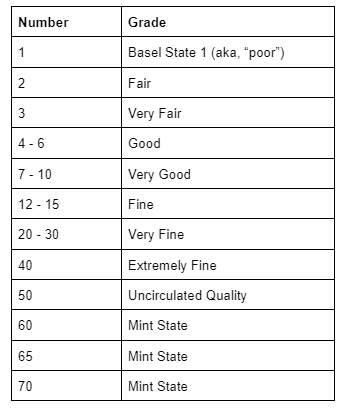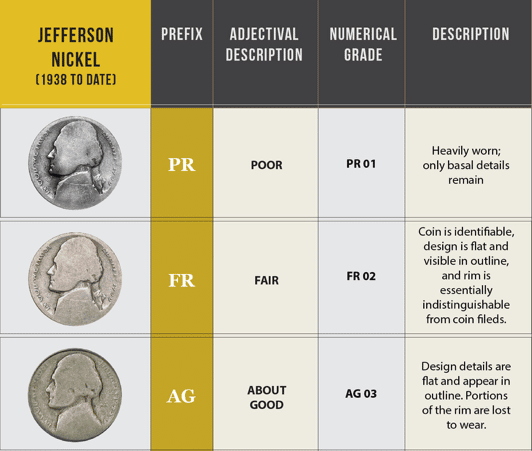- The Sheldon Coin Grading Scale is one of the most widely used grading systems for numismatic coins.
- The scale was modified in 1970 to provide greater specificity of criteria.
- If you want to understand the Sheldon scale, you’d better become familiar with its coding designations (and there are many of them)
Assessing the Quality of Each Coin
You visit a precious metals website hoping to buy your first set of coins. Your goal is to find coins that are considered reasonably rare, well struck, aesthetically appealing, and affordable. In short, you want to buy the best set of coins at the most reasonable price.
The quality of each coin is listed. And that’s where you hit a snag, because the quality is listed using a set of codes with which you’re not entirely familiar. They go something like this: PO, VG8, EF40, MS64, MS65, and so on. What the heck?
Guess what…there are about 70 of them. And some codes even have alternatives. Welcome to the Sheldon Coin Grading Scale.
What is the Sheldon Coin Grading Scale?
The Sheldon Coin Grading Scale is a system for designating quality in numismatic coins. It has 70 points, each representing different states of quality (note, however, that the points occasionally skip numbers).
The Shedon scale is one of the most widely-adopted grading standards for numismatic coins. In other words, most precious metals dealers and coin collectors across the globe refer to this scale when listing quality standards. So, it helps to know the Sheldon scale if you plan on becoming a serious collector or investor.

Who developed this scale?
The “original” scale was created by William Herbert Sheldon in 1949. Sheldon was a psychologist and “numismatist,” a stuffy word for sophisticated collector, dealer, or “scholar” of numismatic items (hint: not many people use that word today).
By the way, have you noticed how we put “original” in quotes? That’s because the scale was modified in the 1970s. The scale was applied to all US coins. Plus, the modifications made the criteria more specific.
Before we explain the current version of the Sheldon scale, let’s first take a look at the original.
What do Sheldon’s original 70 points designate?
In a nutshell, it designates the poorest to highest quality, 70 being the highest. Here’s what it looks like by grade.

Might this scale be helpful in designating coin quality? Well, sort of. It does leave a lot of questions unanswered though. For example, what’s the difference between a FIne 12 and 14, a Very Fine 25 and 26, or a Mint 60 and 65?
The coin world needed a bit more specificity, and so the American Numismatic Association (ANA) modified Sheldon’s original scale in the 1970s.
The Adapted Sheldon Coin Grading Scale
The scale is divided into two sections. Points 1 - 58 grades coins that were once in circulation while points 60 - 70 are reserved for uncirculated coins (hence the “Mint State” grading). Also, note that some numbers are skipped.
We’re going to list the points in this order: Grade number - Grade - Grade Code. Then we’ll explain the criterion for each point.
Points 1 - 58 for circulated coins
1 - Poor - PO
Many grade 1 coins tend to be badly corroded or worn smooth but you can see the date, and perhaps even the type and mintmark
2 - Fair - FR
Some details are visible but most of the coin is worn flat on both sides.
3 - About Good - AG
The lettering is readable though it may be heavily worn. The date and design are worn flat.
4 - Good - G, G4
The design is visible but faint in certain areas. Rims are slightly worn. Peripheral lettering is almost full. Parts of the coin are worn flat.
6 - Choice Good - G+, G6
Peripheral lettering is full and the rims are complete.
8 - Very Good - VG, VG8
Some detail is visible. Two to three of the letters of the word LIBERTY are visible. Rims remain full.
10 - Choice Very Good - VG+, VG10
Most design details have been worn flat though most of the lettering remains readable. Five or six letters of the world LIBERTY may be visible.
12 - Fine - F, F12
Half of the detail is worn flat but lettering is sharp and clear.
15 - Choice Fine - F+, F15
More than half of the detail is visible. Lettering is sharp and clear.
20 - Very Fine - VF, VF20
Higher surface detail is showing moderate wear.
25 - Very Fine - VF25
All lettering and design features are sharp and clear, despite showing some wear on the surface.
30 - Choice Very Fine - Ch.VF, VF+, VF30
All lettering and major design features remain sharp despite light but even wear across the entire surface.
35 - Choice Very Fine -Ch.VF, VF+, VF35
Lettering and major features are sharp, wear is light and even, and traces of mint luster may be visible.
40 - Extremely Fine/Extra Fine - Ex. Fine, EF40, XF40
Coin features are sharp overall with light wear visible at the highest points. Traces of mint luster may be visible.
45 - Choice Extremely Fin - Ch. Ex. Fine, EF45, XF45
Details are full and sharp despite slight wear at the highest points of the coin. Mint luster shows on protected areas of the coin’s surface.
50 - About Uncirculated/Almost Uncirculated - AU, AU50
Traces of wear are visible at the highest points of the coin. The coin retains more than half of the original mint luster.
53 - About Uncirculated/Almost Uncirculated - AU, AU53
Fewer traces of wear are visible at the highest points of the coin. The coin retains more than half of the original mint luster.
55 - Choice About Uncirculated - Ch. AU, AU55
Details can be seen in full. Three-fourths of the coin’s original mint luster remains.
58 - Choice About Uncirculated - Ch. AU, AU58
Virtually all of the original mint luster remains. Slight friction is visible at the highest points of the coin.
Points 60 - 70 for uncirculated coins
The following grades are for coins that were minted for distribution but never circulated. Since these coins were never used for transactions nor were they handed down from one person to another, none of them should show any signs of wear. Hence, they remain in mint condition, aka “mint state.”
60 - Mint State or Proof 60 - MS60, PR60
Coin is in mint condition but poorly struck. Contact marks (nicks) and other damage spots are present but none of it is due to wear.
61 - Mint State or Proof 61 - MS61, PR61
Coin displays an average yet weak strike. Its mint luster is impaired with visible scuff marks, rim nicks, and other defects.
62 - Mint State or Proof 62 - MS60, PR62
Coin is of an average to below average strike. Numerous marks are visible.
63 - Mint State or Proof 63 - MS63, PR63
The coin’s strike is average and contains just a moderate amount of marks.
64 - Mint State or Proof 64 - MS64, PR64
The strike is average to above average. Marks are scattered across the coin’s surface though none of them are severe.
65 - Mint State or Proof 65 - MS65, PR65
Strike is above average. The marks are minor and are outside the coin’s focal areas.
66 - Mint State or Proof 66 - MS66, PR66
The coin has an above-average strike. Its marks, few in number, are outside the focal areas.
67 - Mint State or Proof 67 - MS67, PR67
The coin has a sharp strike with full luster. Its imperfections, noticeable without magnification, do not detract from its aesthetic qualities.
68 - Mint State or Proof 68 - MS68, PR68
The coin has a sharp strike with full luster; its eye appeal is exceptional. Imperfections are few and barely visible.
69 - Mint State or Proof 69 - MS69, PR69
The coin has a sharp strike with full luster; its eye appeal is exceptional. Imperfections are few and visible only under close inspection.
70 - Mint State or Proof 70 - MS70, PR70
The coin is perfectly minted. No imperfections are visible under 5x magnification




